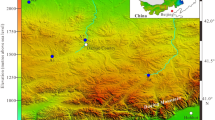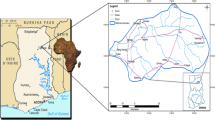Abstract
This study represents the first attempt to study soil water δ18O profiles in Ghana using a mechanical auger. In this paper, the characteristics of δ18O and δ2H in rain water, surface water, soil water and groundwater have been used to understand the transformation mechanism of rain water to groundwater. Rain waters were sampled in Koforidua and Accra. Surface water and groundwater were sampled from the Densu River and selected boreholes in the basin, respectively. Soil waters were taken from three typical sites, namely, Potroase (POT), Teacher Mante (TM) and Ayikai Doblo (AD) in the northern, middle and southern zone from 0.00- to 6-m depth. The soil water was extracted using vacuum distillation method. The distribution of the stable isotopes of rain water is influenced by rainfall amount with minimal temperature effect. In general, the soil water is of meteoric origin undergoing fractionation-controlled evaporation. In the middle zone, the soil water shows some evidence of recharge from enriched source. The three profiles show similar trend of enriched values in the upper depths with gradual depletions of δ18O with depth. The POT profile showed relatively more depleted values suggesting a fast infiltration. In all the three profiles, soil waters below 3 m were found to contribute to groundwater recharge with piston flow as the dominant mechanism. The study also revealed that there is a significant contribution of enrich source to the groundwater system leading to the dilution of the infiltrating water by the large aquifer.









Similar content being viewed by others
References
Acheampong, S. Y., & Hess, J. W. (2000). Origin of the shallow groundwater system in the southern Voltaian Sedimentary Basin, Ghana. Hydrogeology Journal, 6(2000), 527–537.
Adomako, D., Maloszewski, P., Stumpp, C., Osae, S., & Akiti, T. T. (2010a). Estimating groundwater recharge from water isotope (δ 2H, δ18O) depth profiles in the Densu River basin, Ghana. Hydrological Sciences Journal, 55(8), 1405–1416.
Adomako, D., Osae, S., Akiti, T. T., Faye, S., & Maloszewski, P. (2010b). Geochemical and isotopic studies of groundwater conditions in the Densu River Basin of Ghana. Environmental Earth Science. doi:10.1007/s12665-010-0595-2.
Akiti, T. T., (1986). Environmental isotope study of groundwater in crystalline rocks of the Accra Plains. In: 4th working meeting on isotopes in nature. Proceedings of an advisory group meeting. Vienna: IAEA.
Al-Gamal, S. A. (2011). An assessment of recharge possibility to North-Western Sahara Aquifer System (NWSAS) using environmental isotopes. Journal of Hydrology, 398, 184–190.
Allison, G. B., & Hughes, M. W. (1983). The use of natural tracers as indicators of soil–water movement in a temperate semi-arid region. Journal of Hydrology, 60, 157–173.
Anornu, G. K., Kabo-bah, A. T., & Anim-Gyampo, M. (2012). Evaluation of groundwater vulnerability in the Densu River basin of Ghana. American Journal of Human Ecology, 1(3), 79–86.
Aragua’s-Aragua’s, L., Rozanski, K., Gonfiantini, R., & Louvat, D. (1995). Isotope effects accompanying vacuum extraction of soil water for stable isotope analyses. Journal of Hydrology, 168, 159–171.
Banoeng-Yakubu, K. B. (1989). Occurrence of groundwater in basement complex rocks of the Upper Region of Ghana. MSc Thesis, Obefemi-Awolowol University, Geology Department, p 187.
Barnes, C. J., & Allison, G. B. (1983). The distribution of deuterium and oxygen-18 in dry soils: I. Theory. Journal of Hydrology, 60(141), 156.
Blake, G. R., & Hartge, K. H.(1986). Bulk density. In: A. Klute (Ed.), Methods of soil analysis, 2nd edn. Part I. Physical and mineralogical methods, 363–375. Agronomy Monograph no. 9.
Bristow, K. L., & Horton, R. (1996). Modeling the impact of partial surface mulch on soil heat and water flow. Theoretical and Applied Climatology, 54, 85–98.
Buckley, D. K. (1986). Report on advisory to Water Aid projects in Ghana. Unpublished report (p. 56). Willingford: British Geological Survey, Hydrogeology Research Group.
Cappa, C. D., Hendricks, M. B., DePaolo, D. J., & Cohen, R. C. (2003). Isotopic fractionation of water during evaporation. Journal of Geophysical Research–Atmospheres, 108(D16), 1–10.
Chung, S. O., & Horton, R. (1987). Soil heat and water flow with a partial surface mulch. Water Resources Research, 23, 2175–2186.
Clark, I. D., & Fritz, P. (1997). Environmental isotopes in hydrogeology (p. 328). New York: Lewis.
Coleman, M. L., Shepherd, T. J., Durham, J. J., Rouse, J. E., & Moore, G. R. (1982). Reduction of water with zinc for hydrogen isotope analysis. Analytical Chemistry 54, 993–995.
Coplen, T. B. (1988). Normalization of oxygen and hydrogen isotope data. Chemical Geology, 72, 293–297.
Craig, H. (1961). Isotopic variations in meteoric waters. Science, 133, 1702–1703.
Dansgaard, W. (1964). Stable isotopes in precipitation. Tellus, 16, 436–467.
Dickson, K. B., & Benneh, G. (1998). A new geography of Ghana, 27– 52. Harlow: Longman Group UK Ltd.
Epstein, S., & Mayeda, T. K. (1953). Variations of 18O content of waters from natural sources. Geochimica et Cosmochimica Acta, 4, 213–224.
Fianko, J. R., Osae, S., Adomako, D., & Achel, D. G. (2009). Relationship between land use and groundwater quality in six districts in the eastern region of Ghana. Environmental Monitoring and Assessment, 153, 139–146. doi:10.1007/s10661-008-0344-0.
Fontes, J. C. (1980). Environmental isotopes in groundwater hydrology in handbook of environmental isotopes geochemistry, Fritz and Fontes. (pp. 75-140) Vol. 1. Elsevier.
Fontes, J. C., & Olivry, J. C. (1976). Gradient isotopique entre 0 et 4000 m dans les precipitations du Mont Cameroun. Re’sume, CR Reun Ann Sci Terre, Paris, Soc. Ge’olo. Franc¸ ais, pp 1–171.
Ganyaglo, S. Y., Banoeng-Yakubo, K. B., Osae, S., Dampare, S. B., Fianko, J. R., & Bhuiyan, M. A. H. (2006). Hydrochemical and isotopic characterisation of groundwater in eastern region of Ghana. Journal of Water Resource and Protection, 2(3), 2–8.
Gat, J. R., Mook, W. G., & Meijer, A. J. (2001). Atmospheric water. In W. G. Mook (Ed.), Environmental isotopes in the hydrological cycle: principles and applications (Vol. 2). Paris: UNESCO. IHP-V, Technical document no. 39.
Gazis, C., & Feng, X. (2004). A stable isotope study of soil water: evidence for mixing and preferential flow paths. Geoderma, 119, 97–111.
Gehrels, J. C., Peeters, J. E. M., De Vries, J. J., & Dekkers, M. (1998). Mechanism of soil water movement as inferred from 18O stable isotope studies. Hydrological Sciences Journal, 43, 579–594.
Ghana Statistical Service. (2000). Population and housing census. Summary report on final results. Accra: Medialite co. Ltd.
Gibrilla, A., Akiti, T. T., Osae, S., Adomako, D., Ganyaglo, S. Y., Bam, E. P. K., & Hadisu, A. (2010). Origin of dissolve ions in groundwaters in the northern Densu River Basin of Ghana using stable isotopes of 18O and 2H. Journal of Water Resource and Protection, 2, 1010–1019.
Gourcy, L. L., Groening, M., Aggarwal, P. K. (2005). Stable oxygen and hydrogen Isotopes in precipitation. In P. K. Aggarwal, J. R. Gat, K. F. O. Froehlich (Eds.), Isotope in the cycle: past, present and future of a developing science. Elsevier, Amsterdam, pp 39–51. Springer, Dordrecht, Chapter 4, 39–52.
IAEA. (2001). Environmental isotopes in the hydrological cycle, principles and applications, Vol III: surface water. Vienna: IAEA.
Junner, N. R. (1935). Gold in the Gold Coast. Mem. Gold Coast Geol. Surv. 4.
Junner, N. R. (1940). Geology of the Gold Coast and Western Togoland. Gold Coast Geol. Surv. Bull. 10.
Komor, S. C., & Emerson, D. G. (1994). Movements of water, solutes, and stable isotopes in the unsaturated zones of two sand plains in the upper Midwest. Water Resources Research, 30, 253–267.
Lapworth, D. J., MacDonald, A. M., Tijani, M. N., Darling, W. G., Gooddy, D. C., Bonsor, H. C., & Araguas- Araguas, L. J. (2012). Residence times of shallow groundwater in West Africa: implications for hydrogeology and resilience to future changes in climate. Hydrogeology Journal, 21, 673–686.
Leube, A., & Hirdes, W. (1986). The Birimian Supergroup of Ghana—depositional environment, structural development and conceptual model of an early Proterozoic suite. Rep. Arch. BGR 99529.
Li, F., Song, X., Tang, C., Liu, C., Yu, J., & Zhang, W. (2007). Tracing infiltration and recharge using stable isotope in Taihang Mt., North China. Environmental Geology, 53, 687–696. doi:10.1007/s00254-007- 0683-0.
Mazor, E. (2004). Chemical and isotopic groundwater hydrology. New York: Dekker.
Mook, W. G. (2006). Introduction to isotope hydrology: stable and radioactive isotopes of hydrogen, oxygen and carbon. London: Taylor & Francis.
Munnich, K, O., Sonntag, C., Christmann, D., Thoma, D. (1980). Isotope fractionation due to evaporation from sand dunes. 2. Mitt. Zentralinst. Isot. Stralenforsch., 29, 319∼332.
Parry, M. L., Canziani, O. F., Palutikof, P., Van der Hanson, P. J., & Hanson, C. E. (2007). Climate change 2007: impacts, adaptation and vulnerability. Contribution of working groups II to the fourth assessment report of the IPCC. Cambridge: Cambridge University Press.
Ritsema, C. J., & Dekker, L. W. (1998). Three-dimensional patterns of moisture, water repellency, bromide and pH in a sandy soil. Journal of Contaminant Hydrology, 31, 295–313.
Ritsema, C. J., Dekker, L. W., Van den Elsen, E. G. M., Oostindie, K., Steenhius, T. S., & Nieber, J. L. (1997). Recurring fingered flow pathways in a water repellent sandy field soil. Hydrology and Earth System Sciences, 1, 777–786.
Seismos, P. (1984). “The 30 well project,” Internal Report. Catholic Diocese of Accra (p. 40).
Song, X., Wang, S., Xia, G., Mang, Z., Liu, X., & Wang, P. (2009). A study of soil water movement combining soil water potential with stable isotopes at two sites of shallow groundwater areas in the North China Plain. Hydrological Processes, 23, 1376–1388.
Van Ommen, H. C., Van Genuchten, M. T., Van der Molen, W. H., Dijksma, R., & Hulsho, J. (1989). Experimental and theoretical analysis of solute transport from a diffuse source of pollution. Journal of Hydrology, 105, 225–251.
Vincent, M., Didon-Lescot, J., & Couren, M. (2001). Investigation of the hydrological processes using chemical and isotopic tracers in a small Mediterranean forested catchment during autumn recharge. Journal of Hydrology, 247, 215–229.
Walker, G. R., Hughes, M. W., Allison, G. B., & Barnes, C. J. (1988). The movement of isotopes of water during evaporation from a bare soil surface. Journal of Hydrology, 97, 181–197.
WRI. (1994). Borehole yield map of Ghana. Unpublished Technical Report. Water Research Institute, pp 1–10.
Yidana, S. M. (2013). The Stable Isotope Characteristics of Groundwater in the Voltaian Basin – An Evaluation of the Role of Meteoric Recharge in the Basin. Journal of Hydroscience and Hydraulic Engineering, 2, 2.
Zimmermann, U., Munnich, K. O., & Roether, W. (1967). Downward movement of soil moisture traced by means of hydrogen isotopes. Isotope techniques in the hydrologic cycle. American Geophysical Union Geophysical Monograph Series, 11, 28–3.
Acknowledgments
The authors are very grateful to the Director of National Nuclear Research Institute, Ghana Atomic Energy Commission (GAEC) and International Atomic Energy Agency (IAEA) for making funds available for this work. We also thank all the Technicians of the Chemistry Department, GAEC, and Institute of Groundwater Ecology, Munich, Germany, for helping us during the sampling campaigns as well as the analysis. Finally, to our anonymous reviewers, we wish to thank you for making time to review our work and offering valuable suggestions.
Author information
Authors and Affiliations
Corresponding author
Rights and permissions
About this article
Cite this article
Adomako, D., Gibrilla, A., Maloszewski, P. et al. Tracing stable isotopes (δ2H and δ18O) from meteoric water to groundwater in the Densu River basin of Ghana. Environ Monit Assess 187, 264 (2015). https://doi.org/10.1007/s10661-015-4498-2
Received:
Accepted:
Published:
DOI: https://doi.org/10.1007/s10661-015-4498-2




